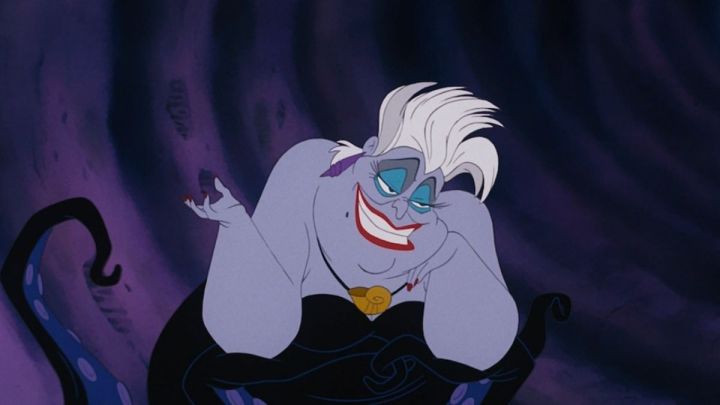Disney villains are an institution for the Mouse House. Far more interesting than the studio’s heroes and often the most memorable part of its films, villains are as important to Disney’s success as the princesses that built the company. Snow White and the Seven Dwarfs was the studio’s first film, but the Evil Queen is far more enduring than the weak and nearly inconsequential girl at the center of the story. The Little Mermaid, the film that launched the Disney Renaissance and established the modern slate of princesses, features a precocious redhead as the protagonist, but it’s the villain, the larger-than-life octopus/woman Ursula, that secured the film a place in the pantheon of animated classics.
Yes, villains are often one of the best parts — if not the best — of these stories. The best Disney films always have a great protagonist, but they often have an even greater villain. Their songs are the catchiest, their designs the most striking, and their behaviors instantly iconic. They are also, for the most part, queer-coded.
Queer coding is the practice of imbuing queer traits into a character without outright declaring them part of the LGBTQ community. Queer coding has long been a way of including LGBTQ-adjacent characters without stating their sexuality openly, and we can trace it back to literary classics like Jane Austen’s Emma and Pride and Prejudice, Virginia Woolf’s Orlando and Mrs. Dalloway, and F. Scott Fitzgerald’s The Great Gatsby. Queer coding became prominent in cinema during the Golden Age of Hollywood, especially after the rise of the Hays Code. However, whereas queer coding in classic literature served to include the oppressed voices and perspectives of LGBTQ people, Disney’s use of it on its villains added further stigma to a community already struggling to be seen and accepted.
Is he … you know?

We could interpret Disney’s use of queer coding on its villains as the studio trying to reaffirm the negative connotations most closely associated with the LGBTQ community. “If you’re gay, you’re evil. And then you die.” Certainly, Disney villains thrived on their queerness, savoring the wickedness of their actions and almost getting off on it. Think of Ursula shaking her hips during Poor Unfortunate Souls, Scar toying with the mouse he’s about to eat in The Lion King, or Governor Ratcliffe gleefully proclaiming his superiority and greed during Mine, Mine, Mine from Pocahontas.
It’s unclear if Disney’s actions were deliberate or if the studio simply went along with the general consensus and voiced what many people already believed about the LGBTQ community, but the overt queerness of their villains is undeniable. If their distinctive designs weren’t enough, their larger-than-life personas drove the point home. Yet, in painting the LGBTQ+ community in a negative light, Disney unintentionally popularized the very same traits it was trying to vilify.
Sure, the queerness of these characters might’ve still been “evil,” but it was also more mainstream than ever. And for a community that spent so long hiding in the shadows out of shame and fear, any representation worked, even when closely associated with villains. Perhaps that’s why villains became so beloved during the new millennium. With LGBTQ representation as scarce as it was back during the Hays Code, villains became the leaders of a community striving to find anything that resembled them in major motion pictures. This reception, in turn, led to the reframing of the villains as complex and perhaps misunderstood characters rather than one-dimensional creatures of greed and hatred, leading to the modern state of Disney villainy.
The redemption of the Disney villain

Maleficent (2014) was the first in a series of films that retooled Disney’s classic stories from the villain’s perspective. Maleficent enhanced the queer aspects of the character’s story, presenting her as a figure othered by a closed-minded and ignorant society. A failed straight romance was at the center of her descent to villainy, but Maleficent’s queerness was more present than ever, the sole “other” in a world of fairies, princesses, and kings. The film received mixed reviews from critics, but was a major box office success, grossing $758 million worldwide. The studio now had another vertical for its ever-growing machine, and future villain-focused projects received the green light.
Disney kicked it up a notch with 2021’s Cruella, another retelling of a classic villain reframed under a forgiving queer eye. Deliciously played by Emma Stone, the Cruella de Vil in Cruella is a queer fantasy come to life. She’s fierce, unapologetic, wild, loud, bold, and unstoppable, a figure for a queer generation raised on Drag Race and antiheroes. Unlike the original version — a withered and unsympathetic woman, ugly within and without — Stone’s Cruella is fabulous. Even the film’s villain — the Baroness played by Emma Thompson, who is, in many ways, a better adaptation of the original Disney character than Stone’s take — is far from repellent.
The reframing of Disney’s queer villains faced an uphill battle from the beginning, mainly because the studio’s efforts seemed shamelessly self-interested and money-oriented. Unlike its predecessor, the reception to Maleficent: Mistress of Evil was more lukewarm, and the film grossed only $491 million worldwide. Cruella wasn’t a definitive hit, although that had more to do with it being released in the middle of a global pandemic. After spending millions of dollars on it, Disney recently put the Gaston and Lefou-centric show — starring openly gay actor Luke Evans — on hold. Is this the sign that this new angle for Disney villains is over already? A sequel for Cruella is coming, but the studio hasn’t greenlit any other villain-centric project.
Disney and its problem with queer coding

The truth is that Disney is not invested in representation, not really. The studio is notoriously self-interested, especially under Bob Chapek’s divisive leadership. The villain-centric movies served to dispel some negative connotations surrounding the characters’ queerness, but that was never its purpose. Indeed, they existed to make money and capitalize on nostalgia, plain and simple.
If Disney truly cared about representation, it would’ve used the upcoming live-action remake of The Little Mermaid to make a statement. What better character to do it than Ursula? Famously based on notorious drag queen Divine, Ursula provided the studio with a genuine chance to enact change, perhaps by casting a male actor in the role or a trans woman. Renowned Broadway actor Titus Burgess could’ve been an inspired choice to bring Ursula to life, as would have been trans actresses like Laverne Cox and Michaela Jaé Rodriguez. Melissa McCarthy is an accomplished actress, but her casting as Ursula is a huge missed opportunity.
Therein lies the issue with Disney and queer coding: The studio has never used it as a force for change. Instead, it employed it to make its villains more distinctive and hateable, then tried to exploit it to capitalize on the LGBTQ community’s increased presence in pop culture. The Mouse House is disingenuous in its efforts, and audiences aren’t fooled; they never were.
So what’s next for Disney villainy? As the studio moves away from traditional princess stories in a conscious effort to diversify its overwhelmingly white and straight slate of films, the classic queer Disney villain may be a thing of the past, and it’s for the best. After all, it was great seeing two Emmas locking horns while draped in outlandish costumes, but the LGBTQ community is way past settling for vague suggestions of queerness. We’re fine with openly queer, complex, and fabulous villains, but the studio needs to understand something: Bad guys aren’t bad because they’re queer. It’s 2022, and queerness is not an evil thing to be feared or judged.
Editors' Recommendations
- ‘Is he … you know?’: Literature’s best queer-coded characters
- It’s official: Marvel’s Black Widow movie will debut on Disney+ and in theaters



